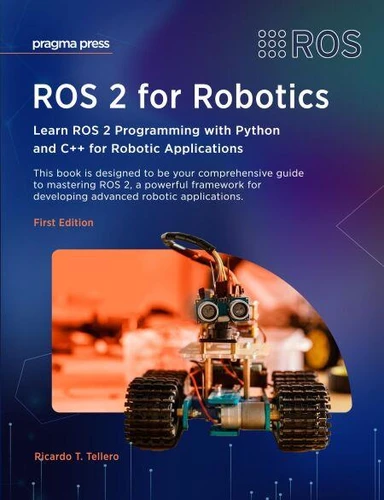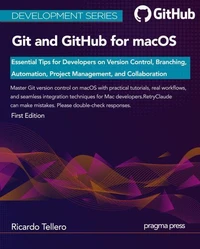Nouveauté
ROS 2 for Robotics: Learn ROS 2 Programming with Python and C++ for Robotic Applications
Par :Formats :
Disponible dans votre compte client Decitre ou Furet du Nord dès validation de votre commande. Le format ePub est :
- Compatible avec une lecture sur My Vivlio (smartphone, tablette, ordinateur)
- Compatible avec une lecture sur liseuses Vivlio
- Pour les liseuses autres que Vivlio, vous devez utiliser le logiciel Adobe Digital Edition. Non compatible avec la lecture sur les liseuses Kindle, Remarkable et Sony
 , qui est-ce ?
, qui est-ce ?Notre partenaire de plateforme de lecture numérique où vous retrouverez l'ensemble de vos ebooks gratuitement
Pour en savoir plus sur nos ebooks, consultez notre aide en ligne ici
- FormatePub
- ISBN8231230938
- EAN9798231230938
- Date de parution14/07/2025
- Protection num.pas de protection
- Infos supplémentairesepub
- ÉditeurWalzone Press
Résumé
Discover the next generation of the Robot Operating System with ROS 2, a powerful framework that enables developers and enthusiasts to build and scale robotics applications faster than ever. This comprehensive guide walks you through every stage of ROS 2 development-from installation on multiple platforms to creating advanced robotic behaviors, integrating sensors, and deploying distributed, multi-robot systems. Key Features Comprehensive Introduction to ROS 2: Start with the fundamentals of the Robot Operating System and transition from ROS 1 to ROS 2 smoothly.
Hands-On Python and C++ Examples: Learn how to build, test, and debug ROS 2 nodes using two of the most popular programming languages for robotics. Gazebo Simulation & URDF Robot Models: Design and simulate robots in Gazebo, then bring them to life with custom URDF robot models for sensors and actuators. Advanced Communication Techniques: Dive into topics, services, actions, and ROS 2 parameters with real-world examples.
Explore TF in ROS 2 and QoS profiles to optimize performance. RViz Visualization & ROS 2 Launch Files: Seamlessly integrate RViz visualization to monitor your robots and craft robust ROS 2 launch files for streamlined project setup. Multi-Robot Coordination & Distributed Systems: Learn how to scale your projects for multi-robot systems, ROS 2 best practices, and inter-process communication strategies with DDS.
What You'll Explore Inside ROS 2 Installation & Environment SetupGet step-by-step instructions for setting up ROS 2 on Ubuntu, Windows, and macOS, and learn best practices for configuring your workspace. Core ROS 2 ConceptsUnderstand the building blocks: ROS 2 nodes, topics, services, actions, and how to manage parameters for dynamic reconfiguration. Creating Custom Packages & Robot ModelsMaster Python and C++ in ROS 2 to build efficient packages.
Design and create a custom robot with URDF for accurate simulation and control. Simulation in GazeboDiscover how to simulate robots in Gazebo-from setting up the environment to spawning and controlling robots with ROS 2 for realistic testing. Navigation, SLAM, and LocalizationIntegrate sensors like cameras, LIDAR, and IMU. Implement navigation algorithms for autonomous movement and explore SLAM for real-time mapping.
Advanced System Architecture & Multi-Robot CoordinationScale your projects to multiple robots, leverage ROS 2 best practices, and understand the DDS middleware for robust interprocess communication. ROS 2 for Real-World ApplicationsLearn to deploy on embedded hardware, integrate with IoT devices, and connect with cloud services to build production-level robotics solutions.
Hands-On Python and C++ Examples: Learn how to build, test, and debug ROS 2 nodes using two of the most popular programming languages for robotics. Gazebo Simulation & URDF Robot Models: Design and simulate robots in Gazebo, then bring them to life with custom URDF robot models for sensors and actuators. Advanced Communication Techniques: Dive into topics, services, actions, and ROS 2 parameters with real-world examples.
Explore TF in ROS 2 and QoS profiles to optimize performance. RViz Visualization & ROS 2 Launch Files: Seamlessly integrate RViz visualization to monitor your robots and craft robust ROS 2 launch files for streamlined project setup. Multi-Robot Coordination & Distributed Systems: Learn how to scale your projects for multi-robot systems, ROS 2 best practices, and inter-process communication strategies with DDS.
What You'll Explore Inside ROS 2 Installation & Environment SetupGet step-by-step instructions for setting up ROS 2 on Ubuntu, Windows, and macOS, and learn best practices for configuring your workspace. Core ROS 2 ConceptsUnderstand the building blocks: ROS 2 nodes, topics, services, actions, and how to manage parameters for dynamic reconfiguration. Creating Custom Packages & Robot ModelsMaster Python and C++ in ROS 2 to build efficient packages.
Design and create a custom robot with URDF for accurate simulation and control. Simulation in GazeboDiscover how to simulate robots in Gazebo-from setting up the environment to spawning and controlling robots with ROS 2 for realistic testing. Navigation, SLAM, and LocalizationIntegrate sensors like cameras, LIDAR, and IMU. Implement navigation algorithms for autonomous movement and explore SLAM for real-time mapping.
Advanced System Architecture & Multi-Robot CoordinationScale your projects to multiple robots, leverage ROS 2 best practices, and understand the DDS middleware for robust interprocess communication. ROS 2 for Real-World ApplicationsLearn to deploy on embedded hardware, integrate with IoT devices, and connect with cloud services to build production-level robotics solutions.
Discover the next generation of the Robot Operating System with ROS 2, a powerful framework that enables developers and enthusiasts to build and scale robotics applications faster than ever. This comprehensive guide walks you through every stage of ROS 2 development-from installation on multiple platforms to creating advanced robotic behaviors, integrating sensors, and deploying distributed, multi-robot systems. Key Features Comprehensive Introduction to ROS 2: Start with the fundamentals of the Robot Operating System and transition from ROS 1 to ROS 2 smoothly.
Hands-On Python and C++ Examples: Learn how to build, test, and debug ROS 2 nodes using two of the most popular programming languages for robotics. Gazebo Simulation & URDF Robot Models: Design and simulate robots in Gazebo, then bring them to life with custom URDF robot models for sensors and actuators. Advanced Communication Techniques: Dive into topics, services, actions, and ROS 2 parameters with real-world examples.
Explore TF in ROS 2 and QoS profiles to optimize performance. RViz Visualization & ROS 2 Launch Files: Seamlessly integrate RViz visualization to monitor your robots and craft robust ROS 2 launch files for streamlined project setup. Multi-Robot Coordination & Distributed Systems: Learn how to scale your projects for multi-robot systems, ROS 2 best practices, and inter-process communication strategies with DDS.
What You'll Explore Inside ROS 2 Installation & Environment SetupGet step-by-step instructions for setting up ROS 2 on Ubuntu, Windows, and macOS, and learn best practices for configuring your workspace. Core ROS 2 ConceptsUnderstand the building blocks: ROS 2 nodes, topics, services, actions, and how to manage parameters for dynamic reconfiguration. Creating Custom Packages & Robot ModelsMaster Python and C++ in ROS 2 to build efficient packages.
Design and create a custom robot with URDF for accurate simulation and control. Simulation in GazeboDiscover how to simulate robots in Gazebo-from setting up the environment to spawning and controlling robots with ROS 2 for realistic testing. Navigation, SLAM, and LocalizationIntegrate sensors like cameras, LIDAR, and IMU. Implement navigation algorithms for autonomous movement and explore SLAM for real-time mapping.
Advanced System Architecture & Multi-Robot CoordinationScale your projects to multiple robots, leverage ROS 2 best practices, and understand the DDS middleware for robust interprocess communication. ROS 2 for Real-World ApplicationsLearn to deploy on embedded hardware, integrate with IoT devices, and connect with cloud services to build production-level robotics solutions.
Hands-On Python and C++ Examples: Learn how to build, test, and debug ROS 2 nodes using two of the most popular programming languages for robotics. Gazebo Simulation & URDF Robot Models: Design and simulate robots in Gazebo, then bring them to life with custom URDF robot models for sensors and actuators. Advanced Communication Techniques: Dive into topics, services, actions, and ROS 2 parameters with real-world examples.
Explore TF in ROS 2 and QoS profiles to optimize performance. RViz Visualization & ROS 2 Launch Files: Seamlessly integrate RViz visualization to monitor your robots and craft robust ROS 2 launch files for streamlined project setup. Multi-Robot Coordination & Distributed Systems: Learn how to scale your projects for multi-robot systems, ROS 2 best practices, and inter-process communication strategies with DDS.
What You'll Explore Inside ROS 2 Installation & Environment SetupGet step-by-step instructions for setting up ROS 2 on Ubuntu, Windows, and macOS, and learn best practices for configuring your workspace. Core ROS 2 ConceptsUnderstand the building blocks: ROS 2 nodes, topics, services, actions, and how to manage parameters for dynamic reconfiguration. Creating Custom Packages & Robot ModelsMaster Python and C++ in ROS 2 to build efficient packages.
Design and create a custom robot with URDF for accurate simulation and control. Simulation in GazeboDiscover how to simulate robots in Gazebo-from setting up the environment to spawning and controlling robots with ROS 2 for realistic testing. Navigation, SLAM, and LocalizationIntegrate sensors like cameras, LIDAR, and IMU. Implement navigation algorithms for autonomous movement and explore SLAM for real-time mapping.
Advanced System Architecture & Multi-Robot CoordinationScale your projects to multiple robots, leverage ROS 2 best practices, and understand the DDS middleware for robust interprocess communication. ROS 2 for Real-World ApplicationsLearn to deploy on embedded hardware, integrate with IoT devices, and connect with cloud services to build production-level robotics solutions.




